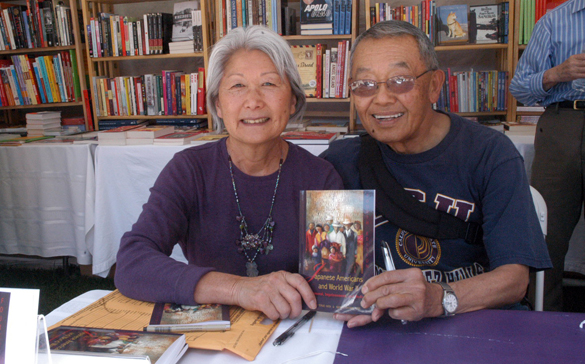California State University, Dominguez Hills is proud to announce the unveiling of a third painting in a series that commemorates the university’s 50th anniversary. “E Pluribus Unum” was created by South Bay artist Hatsuko Mary Higuchi and will be presented to the campus and local community at a reception at 6 p.m. on Thursday, May 12, in the University Library. The evening will include a reading and book signing by Dr. Don Hata, emeritus professor of history, of the fourth edition of “Japanese Americans and World War II: Mass Removal, Imprisonment, and Redress,” which he wrote with his late wife, Dr. Nadine Ishitani Hata, in 1974.

Higuchi says that she created “E Pluribus Unum” to reflect the diversity of the student population at CSU Dominguez Hills, not only in ethnicity, but in circumstance.
“When President [Mildred] García invited me to create a painting for the 50th anniversary of the university, I decided the best way to most accurately depict the uniqueness of CSU Dominguez Hills would be to immerse myself in as many campus events as possible,” says Higuchi. “In the process, I met many students who, like me, were the first in their families to aspire to a university education. Like Ellis Island in New York Harbor, or Angel Island in San Francisco Bay, CSU Dominguez Hills is a port of entry to higher education and the American Dream.”
Hata, who introduced the book’s fourth edition last December at the Albany Civil Rights Institute in Albany, Ga., says that the story of the Japanese American struggle for redress after World War II should be a lesson for all Americans regardless of ethnic origin and those who would violate their rights.
“Most U.S. history textbooks and teachers at all levels barely mention the World War II diaspora and gulag experience of Japanese Americans, and when they do, they still get it wrong,” says Hata. “They treat it as a one-time aberration, and fail to see it as one of many similar episodes that pervade U.S. history. Although the wartime convictions of individuals like Fred Korematsu were vacated in the lower courts, the right of all U.S. citizens to due process remains officially unprotected–hostage to any federal government claim of ‘military necessity.’ The question looms: In the wake of 9-11, can another group of Americans be targeted for racial profiling and mass incarceration?”
Hata was born in 1939 in East Los Angeles and incarcerated at age three at Gila River, Ariz., during World War II due to Executive Order 9066, which authorized the mass removal and incarceration of “all persons of Japanese ancestry” on the West Coast. He taught at CSU Dominguez Hills for 33 years and received the CSU Trustees systemwide “Outstanding Professor Award.” He was elected as planning commissioner and city councilman of the city of Gardena and served on the governing boards of the California Historical Society and Historical Society of Southern California, and was an elected officer of the American Historical Association.
Higuchi, who was born in Los Angeles, was imprisoned with her family as a small child at the U.S. War Relocation Authority Concentration Camp in Poston, Ariz., from 1942 to 1945. Many paintings in her “E.O. 9066” series reflect this chapter in American history with great pathos and have won top awards at major exhibitions hosted by the International Society of Acrylic Painters, the San Diego Watercolor Society International Exhibition, and the Western Federation of Watercolor Societies.
Last August, Hata and Higuchi spoke on “Kids in the Nikkei Gulag-Diaspora,” sharing recollections of their childhoods in the camps at the Manzanar National Historic Site Interpretive Center in Independence, Calif. Higuchi provided the cover art for the fourth edition of Hata’s book.
The reception will take place in on the fifth floor of the University Library’s South Wing and is open to the public. Autographed posters of the painting will be available for purchase.
To RSVP or for more information, please contact the Office of Ceremonies and Events at (310) 243- 3337 or by email to jhdavis@csudh.edu.